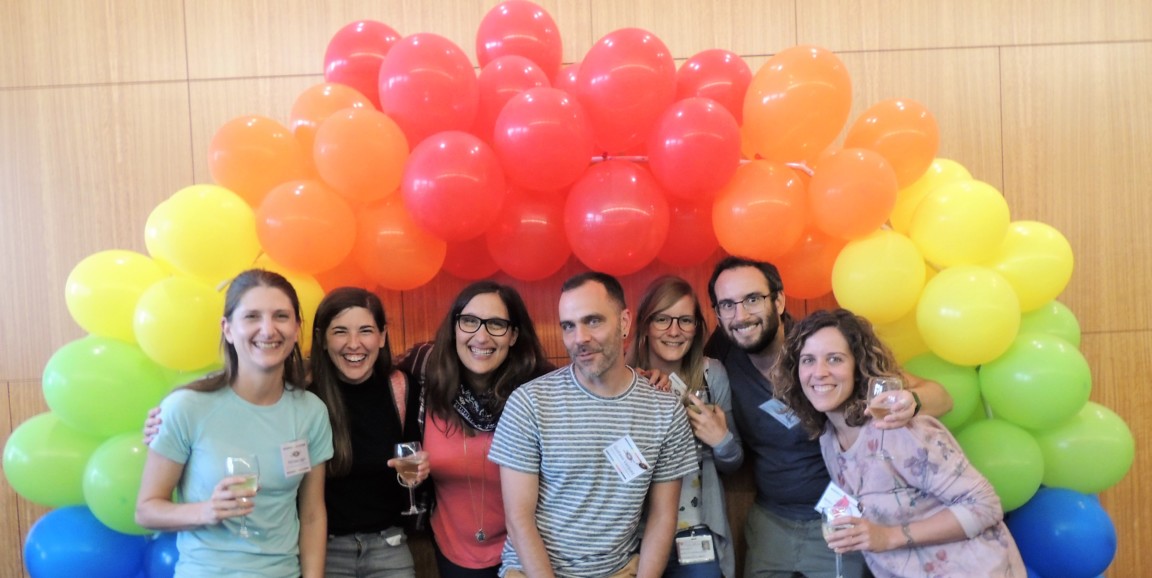A "chosen family" is how some of the speakers described their colleagues here during the first-ever Stanford Medicine LGBTQ+ Forum. Too often those letters -- which stand for lesbian, gay, bisexual, transgender, and queer/questioning -- describe individuals whose sexual orientation or gender identity is kept hidden because it can be so personally and professionally risky to be "out." But on October 10, the visibility-themed event was an unmistakable declaration that LGBTQ+ individuals are a seen, treasured, and essential part of the Stanford Medicine community.
In his opening remarks, Lloyd Minor, MD, dean of the School of Medicine, emphasized the organization's dedication to being a supportive environment for its LBGTQ+ members, and a leader in LGBTQ+ medical education, research and care. He also noted his personal support:
I want to personally commit to each of you, to all of you, that I'm going to stand beside you. I'm going to make sure that we change the fabric and the culture not only of our institutions but also together we can really have an impact on the fabric and culture of our society. ... I think we have an innate responsibility -- as an academic medical center, as a great research university -- to celebrate and embrace diversity and inclusion in all of its aspects.
The event was founded by MD-PhD student Timothy Keyes, who spent more than a year developing the event with fellow members of the LGBTQ-Meds organization and many other sponsors. Faculty supporters like Yvonne "Bonnie" Maldonado, MD, senior associate dean for faculty development and diversity, recognized the importance of the event, because the LGBTQ+ community is what she called an "invisible minority." Keyes was also championed by faculty sponsors Marcia Stefanick, PhD, and James Lock, MD.
In his remarks at the event, Keyes described a visit to Stanford before he had decided to attend. He interviewed with the late neuroscientist Ben Barres, MD, PhD, an openly transgender man, who asked Keyes an unexpected question:
He said, 'Oh, Tim, by the way, are you gay?' And I said, 'Yes, of course.' He had noted something on my CV that was LGBTQ leadership-related. And he said, 'Well, ...I just want to let you know this is a very supportive community here. ...You could come here and be as out as you'd like to be and not have to worry about anything.
It was the first time, Keyes said, that anyone had asked him about his sexuality in a positive way with regard to his career. Keyes went on to say:
It was so meaningful. It made me feel really, really special and ...really seen. And that's why I connected that experience back to visibility, because I felt that Ben saw me in a way that I didn't even realize I needed to be seen to feel at home and like I belonged. Of course, I came here to Stanford because of that and because of him.
Several speakers, both live and in a video, told of their experiences in academic medical environments, and why visibility is so important. Keynote speaker Arturo Molina, MD, MS, president-elect of the Stanford Medicine Alumni Association, described how he kept his sexuality secret for years during medical school and after, but is now a proud husband and father of two. Leslee Subak, MD, chair of obstetrics and gynecology, recalled her efforts at community-building during her residency at UCSF in the late 1980s. Today, Subak is developing Stanford Medicine's new Sexual and Gender Medicine Program, which will include clinical care, research, education and advocacy.
Benjamin Laniakea, MD, clinical assistant professor of medicine, described how sorely lacking the LGBTQ+ health training was when he was in medical school from 2009-2013 -- in all four years, amounting to only a single HIV/AIDS diagnostic question on one exam. Today, he says:
All I want to be able to do is to have [medical students] feel armed with the knowledge and skills to provide appropriate LGB and transgender care, to provide this competent and compassionate care. That's it.
About 350 people attended the afternoon, on-campus event, which included LGBTQ+ individuals and their allies and colleagues from the Stanford School of Medicine, Stanford Health Care, and Stanford Children's Health. Guests were treated to giveaways and delicious food. As much as the gender and sexual minorities at the event were there to be part of a chosen family, their allies and colleagues had chosen to be part of that same family, too.
Finally, as Dean Minor said so eloquently:
In order for each of us to fulfill our potential, we have to feel a part of the fabric of our community. We have to feel, every day, that who we are, inside, is a vital part of who we are as a member of our community... At its heart and core, a place like Stanford is Stanford because of the community that we bring together.
The journey toward visibility and inclusion may not be easy, the dean concluded, but it's one of the most important for Stanford, where our accomplishments can be an example for our entire country and the world.
Photo by Valerie Berland




